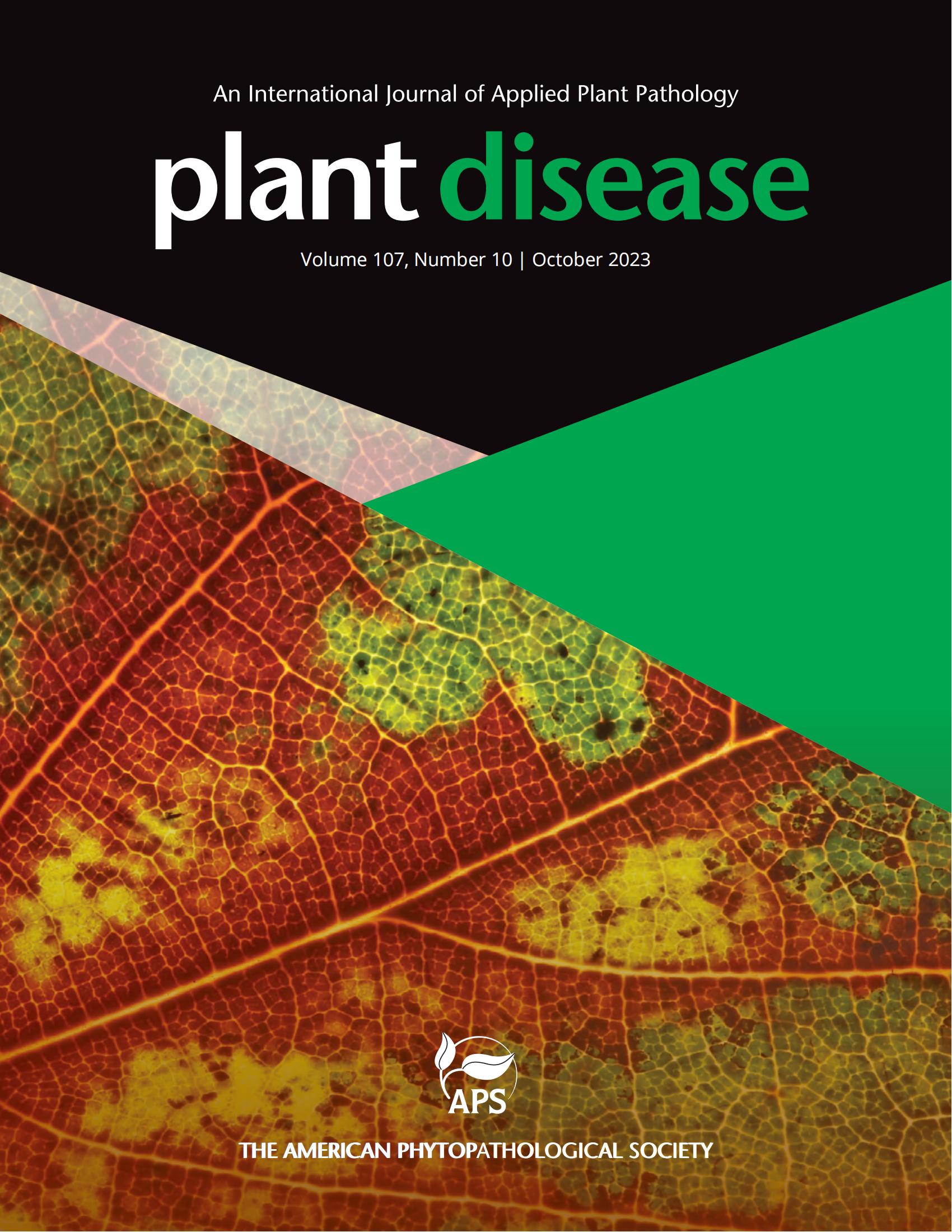William Henry Kohlway, Caleb Phillip Cothron, Solomon Ghezehei, Angela Chiang, Elizabeth Guthrie Nichols, Justin Whitehill
求助PDF
{"title":"边缘疫霉感染圣诞树地优质单板杨的潜力。","authors":"William Henry Kohlway, Caleb Phillip Cothron, Solomon Ghezehei, Angela Chiang, Elizabeth Guthrie Nichols, Justin Whitehill","doi":"10.1094/PDIS-07-24-1558-RE","DOIUrl":null,"url":null,"abstract":"<p><p>The cultivation of Fraser fir (<i>Abies fraseri</i>) Christmas trees in the southern Appalachian Mountains of western North Carolina (WNC) is threatened by the proliferation of Phytophthora root rot (PRR) disease. PRR is primarily caused by the soilborne pathogen <i>Phytophthora cinnamomi</i>. Fraser fir is highly susceptible to <i>P. cinnamomi</i>, which threatens the long-term profitability of the Christmas tree bioeconomy. Therefore, alternative species that tolerate the PRR pathogen and contribute to the rural bioeconomy are needed. For instance, select poplar genotypes produce veneer-quality logs and offer a profitable alternative on infected soils no longer capable of Fraser fir production. However, the resistance, tolerance, or susceptibility of hybrid poplars (<i>Populus</i> spp.) to <i>P. cinnamomi</i> infection is currently unknown. We selected 18 elite veneer clonal <i>P. deltoides</i>, <i>P. trichocarpa</i>, and <i>P. maximowiczii</i> poplar genotypes for <i>P. cinnamomi</i> pathogenicity tests based on prior productivity trials at field sites in WNC. Inoculation of containerized poplar clones was carried out using <i>P. cinnamomi</i>-colonized rice grains. Metrics for poplar growth and physiological traits were collected weekly for 10 weeks after inoculations. Although both <i>P. cinnamomi</i>-inoculated and mock-inoculated poplars survived, <i>P. cinnamomi</i> inoculation significantly impacted the growth of pure <i>P. deltoides</i> crosses. Conversely, <i>P. trichocarpa × P. deltoides</i> hybrids exhibited a greater tolerance to <i>P. cinnamomi</i> inoculations, with no significant growth differences between treatments. These findings support the use of hybrid <i>P. trichocarpa × P. deltoides</i> for veneer production as a potential alternative for Christmas tree farmers impacted by the spread of <i>P. cinnamomi</i>.[Formula: see text] Copyright © 2025 The Author(s). This is an open access article distributed under the CC BY-NC-ND 4.0 International license.</p>","PeriodicalId":20063,"journal":{"name":"Plant disease","volume":" ","pages":"PDIS07241558RE"},"PeriodicalIF":4.4000,"publicationDate":"2025-10-01","publicationTypes":"Journal Article","fieldsOfStudy":null,"isOpenAccess":false,"openAccessPdf":"","citationCount":"0","resultStr":"{\"title\":\"Potential for Elite Veneer Poplar on Marginal <i>Phytophthora</i> spp.-Infected Christmas Tree Lands.\",\"authors\":\"William Henry Kohlway, Caleb Phillip Cothron, Solomon Ghezehei, Angela Chiang, Elizabeth Guthrie Nichols, Justin Whitehill\",\"doi\":\"10.1094/PDIS-07-24-1558-RE\",\"DOIUrl\":null,\"url\":null,\"abstract\":\"<p><p>The cultivation of Fraser fir (<i>Abies fraseri</i>) Christmas trees in the southern Appalachian Mountains of western North Carolina (WNC) is threatened by the proliferation of Phytophthora root rot (PRR) disease. PRR is primarily caused by the soilborne pathogen <i>Phytophthora cinnamomi</i>. Fraser fir is highly susceptible to <i>P. cinnamomi</i>, which threatens the long-term profitability of the Christmas tree bioeconomy. Therefore, alternative species that tolerate the PRR pathogen and contribute to the rural bioeconomy are needed. For instance, select poplar genotypes produce veneer-quality logs and offer a profitable alternative on infected soils no longer capable of Fraser fir production. However, the resistance, tolerance, or susceptibility of hybrid poplars (<i>Populus</i> spp.) to <i>P. cinnamomi</i> infection is currently unknown. We selected 18 elite veneer clonal <i>P. deltoides</i>, <i>P. trichocarpa</i>, and <i>P. maximowiczii</i> poplar genotypes for <i>P. cinnamomi</i> pathogenicity tests based on prior productivity trials at field sites in WNC. Inoculation of containerized poplar clones was carried out using <i>P. cinnamomi</i>-colonized rice grains. Metrics for poplar growth and physiological traits were collected weekly for 10 weeks after inoculations. Although both <i>P. cinnamomi</i>-inoculated and mock-inoculated poplars survived, <i>P. cinnamomi</i> inoculation significantly impacted the growth of pure <i>P. deltoides</i> crosses. Conversely, <i>P. trichocarpa × P. deltoides</i> hybrids exhibited a greater tolerance to <i>P. cinnamomi</i> inoculations, with no significant growth differences between treatments. These findings support the use of hybrid <i>P. trichocarpa × P. deltoides</i> for veneer production as a potential alternative for Christmas tree farmers impacted by the spread of <i>P. cinnamomi</i>.[Formula: see text] Copyright © 2025 The Author(s). This is an open access article distributed under the CC BY-NC-ND 4.0 International license.</p>\",\"PeriodicalId\":20063,\"journal\":{\"name\":\"Plant disease\",\"volume\":\" \",\"pages\":\"PDIS07241558RE\"},\"PeriodicalIF\":4.4000,\"publicationDate\":\"2025-10-01\",\"publicationTypes\":\"Journal Article\",\"fieldsOfStudy\":null,\"isOpenAccess\":false,\"openAccessPdf\":\"\",\"citationCount\":\"0\",\"resultStr\":null,\"platform\":\"Semanticscholar\",\"paperid\":null,\"PeriodicalName\":\"Plant disease\",\"FirstCategoryId\":\"97\",\"ListUrlMain\":\"https://doi.org/10.1094/PDIS-07-24-1558-RE\",\"RegionNum\":2,\"RegionCategory\":\"农林科学\",\"ArticlePicture\":[],\"TitleCN\":null,\"AbstractTextCN\":null,\"PMCID\":null,\"EPubDate\":\"\",\"PubModel\":\"\",\"JCR\":\"Q1\",\"JCRName\":\"PLANT SCIENCES\",\"Score\":null,\"Total\":0}","platform":"Semanticscholar","paperid":null,"PeriodicalName":"Plant disease","FirstCategoryId":"97","ListUrlMain":"https://doi.org/10.1094/PDIS-07-24-1558-RE","RegionNum":2,"RegionCategory":"农林科学","ArticlePicture":[],"TitleCN":null,"AbstractTextCN":null,"PMCID":null,"EPubDate":"","PubModel":"","JCR":"Q1","JCRName":"PLANT SCIENCES","Score":null,"Total":0}
引用次数: 0
引用
批量引用

 求助内容:
求助内容: 应助结果提醒方式:
应助结果提醒方式:


